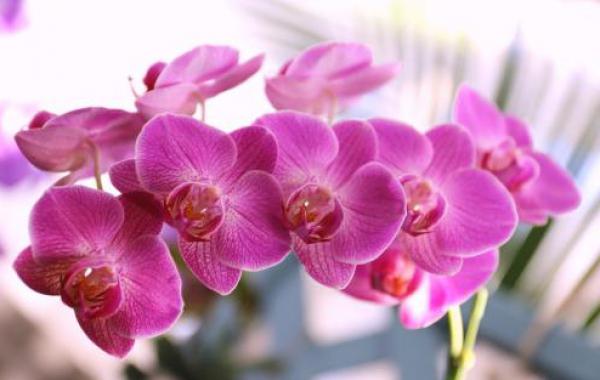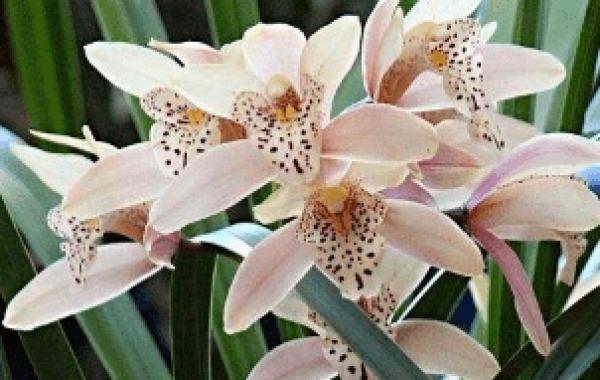How to maintain the flowering period of butterfly orchid

The florescence of Phalaenopsis can be controlled.
The normal flowering period of most varieties of Phalaenopsis is from March to May. It is necessary to regulate the flowering period in order to achieve the Spring Festival flowering.
In the northern region, Phalaenopsis pedicels peak before mid-June and after mid-September. After 5-6 months of vegetative growth and leaf spacing of 30 cm, Phalaenopsis seedlings can be artificially fertilized and supplemented with high phosphorus fertilizer after 5-6 months of vegetative growth. The ratio of nitrogen, phosphorus and potassium is 9 ∶ 45 ∶ 15 and 10 ∶ 30 ∶ 20 alternately to promote flower bud differentiation, and flower buds can be formed from peduncle to flowering in about 45 days.
In the southern region, going up the mountain to promote flower is a more economical and feasible method for the commercial production of Phalaenopsis during the Spring Festival. the mountain conditions at an altitude of 700 to 1000 meters above sea level can provide a large temperature difference between day and night, which can ensure the necessary temperature and day-night temperature difference for flower bud differentiation of Phalaenopsis. When the flower buds grow to a certain extent in 20 to 40 days, they can differentiate into flower buds, and then move to the bottom of the mountain. After greenhouse cultivation, they can blossom during the Spring Festival and choose the period for Phalaenopsis to go uphill. It should be determined according to the age and vegetative growth of the plant that the larger the leaf area is, the earlier the pedicel germinates, the faster the pedicel develops and the earlier the pedicel blossoms.
Watering should be kept moist, usually once every five days or so
Don't fertilize too much, you can not apply fertilizer.
The temperature should not be lower than fifteen degrees.
Half-overcast is fine, strong light should not be directed at it.
How to maintain the butterfly orchid after the flowering period? please explain in detail before you are satisfied with the score.
First, should Phalaenopsis cut flowers and arrows after flowering
After Phalaenopsis blossoms, the flower stem can be cut, but it is best not to cut it all (according to the state of the whole plant, if the roots and leaves are very healthy and strong, it is recommended to keep a few flower stems, usually more than 2 months later can send out new flower buds). Cut from the first flower or the first branch, the remaining flower stalk still has buds and can be reproduced after a certain period of time. For Orchidaceae, do not let it bear fruit, because even if it can bear fruit, it is difficult to reproduce with seeds, and the fruiting process consumes nutrients. Whether it can be fertilized or not can be determined by observing the plant growth after flowering.
Second, how to maintain Phalaenopsis after flowering
Butterflies can be given a little slow-release fertilizer after flowering, should be placed in astigmatism, usually dry and then watered, often spray, be careful not to wet the new buds, otherwise it is easy to rot. Put it in a cool, ventilated place in summer, and it's best not to be less than 15 degrees in winter.
After the rotten roots of Phalaenopsis, the potted soil should be dug out of the flowerpot and scattered, the roots of the plants should be washed with clean water, then all the rotten roots should be cut off, and the intact parts should be preserved as far as possible, and the residual roots may also be saved.
Soak the cut and the remaining roots in 2% potassium permanganate solution for about 10 minutes before drying, and then carefully smear it with plant ash at the cut to re-pot the plant.
The basin soil must be disinfected. The simple way is to pour the basin soil thoroughly with boiling water and use it again after it is cooled. When putting on the basin, pat the rhizome, pour the water thoroughly and place it in the shade, cover it with a film and cultivate it at a temperature of about 20 ℃. After about 20 days, new roots can grow.
The flowering period of Phalaenopsis is from several months to several months.
When family conservation Phalaenopsis, pay attention to the following points: temperature family Phalaenopsis, first of all to ensure the temperature. Phalaenopsis is native to the tropics and likes the environment of high temperature and humidity. The lowest temperature during the growth period should be kept above 15 ℃. Phalaenopsis (especially Phalaenopsis) grows well when the daytime temperature is 27 ℃ and the night temperature is about 18 ℃. At the turn of autumn, winter and spring, and when the winter temperature is low, you should pay attention to warming rooms with heating equipment in winter. It is not difficult to reach this temperature, but be careful not to put the flowers directly on the radiator or too close to it. When the summer temperature is too high, need to cool down, and pay attention to ventilation, if the temperature is higher than 32 ℃, Phalaenopsis will usually enter a semi-dormant state, to avoid continuous high temperature. The flowering period is around the Spring Festival, and proper cooling can prolong the viewing time. The night temperature during flowering should be controlled between 13 ℃-16 ℃, but not less than 13 ℃. Water Phalaenopsis belongs to epiphytic orchids, which are mostly born on tree trunks in the country of origin, and their roots are exposed to the air, which can absorb water from the moist air. When cultivated artificially, the root is buried in the cultivation substrate, such as too much watering, the ventilation of the substrate will become worse, the fleshy root will rot, and the leaves will turn yellow, which will lead to death in serious cases. According to the principle of watering, water should be watered again when the surface of the cultivation substrate becomes dry; generally, watering should be carried out on a sunny morning, and the water temperature should be close to room temperature. When the indoor air is dry, sprayers can be used to spray directly to the leaves, but be careful not to spray water spray on flowers during flowering. Although Phalaenopsis prefers shade, it is still necessary to make the orchid plant accept part of the light, especially before and after flowering, the appropriate light can promote Phalaenopsis to bloom and make the flowers gorgeous and lasting, generally should be placed indoors where there is scattered light, do not let the sun shine directly; if placed on the indoor windowsill, cover part of the sun with a window screen. In nutritional cultivation of Phalaenopsis, aquatic plants and moss are generally selected as the cultivation substrate. The principle of fertilization should be less fertilization and light fertilizer. In the normal growth period, 2000 times of special orchid fertilizer was applied to fertilize the roots, once every 2-3 weeks, depending on the growth. Before flowering, we can choose 15-30-15 water-soluble high-phosphate fertilizer 1000-2000 times liquid, about 10 days to spray once, and stop fertilization in flowering and low temperature seasons. It takes about 2 years from seedling to flowering. The florescence is usually around the Spring Festival, and the viewing period can be as long as 2-3 months. When the flowers wither, the withered flowers should be cut off as soon as possible, which can reduce the consumption of nutrients. If the flower stem is cut off from the basal number of 4-5 nodes, it can blossom again after 2-3 months. However, this kind of plant nutrient consumption is too large, which is not conducive to the growth of the coming year. If you want to blossom again in the coming year, it is best to cut the flower stem from the base, and when the matrix ages, it should be replaced in time, otherwise the air permeability becomes worse, which will cause root rot, weaken plant growth and even die. Generally speaking, it is appropriate to change the basin in May when the new leaves grow.
Maintenance of Phalaenopsis during flowering and how to raise it after flowering
After the bud of butterfly orchid is formed, more phosphorus should be applied until it blossoms. When the flower stem is pulled up and tends to tilt to one side, the pedicel should be tied up so as not to break the pedicel. After that, the pedicel is growing and taller, and the binding should be carried out gradually, and the pillar is slightly curved to enhance the sense of beauty. Stop applying fertilizer during flowering and before new leaves grow.
There are four taboos in the maintenance of the flowering period, the four taboos are to avoid watering flood, fertilizer, high temperature, and flowers without pruning. Phalaenopsis we buy in the flower market are generally cultivated with water moss as the matrix, and the water retention and air permeability of water moss are very good, so don't water too often.
For the robust orchid plant with more than 5 leaves, the lower part of the stem can be shrunk by 3-4 nodes, and it is expected to blossom again on the remaining flower stem in the future.
Related
- Is the orchid suitable for indoor use? Is it good for the body?
- How to prevent the empty root of orchids?
- What to do after the crab claw orchid is withered?
- Why are the leaves of orchids always yellow? Fertilizing and watering.
- Can the root of the gentleman orchid be saved if it is rotten?
- Diagnosis and treatment of cotton-blowing beetle insects in Cymbidium
- There is a way for a gentleman's orchid to rot.
- What is the most suitable temperature and humidity for the orchid?
- How to raise a gentleman's orchid? Cultivation techniques of Cymbidium
- How to prepare the nutritive soil for the cultivation of Cymbidium



